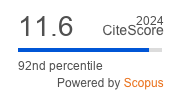SEPARATION AND CLASSIFICATION OF FETAL ECG SIGNAL BY ENHANCED BLIND SOURCE SEPARATION TECHNIQUE AND NEURAL NETWORK
DOI:
https://doi.org/10.29284/ijasis.5.2.2019.7-14Keywords:
Blind source separation, fetal ECG, MULTI-COMBI, feed forward neural network.Abstract
The separation of Fetal ElectroCardioGram (FECG) from mother's Abdominal ECG (AECG) signal is complicated and very important in medical diagnosis during pregnancy. In this study, the separation and classification of FECG signal from AECG signals is presented by a novel method. It uses MULTI-COMBI based Blind Source Separation (BSS) technique to separate the FECG signals. The separated FECG signals have different features, which are extracted using the morphological feature extraction method. These extracted features are used for classification by using Feed Forward Neural Network (FFNN). This classifier classifies the FECG into five different classes. The entire work is implemented in MATLAB. Results show that FFNN gives the classification accuracy of 77.1%, sensitivity of 75.3%, and specificity of 76.7%.
References
A. Kumar, L. Dewan, M. Singh, and H. Kurukshetra, “Real-time monitoring system for ECG signal using virtual instrumentation”, IEEE Transactions on Biology and Biomedicine, vol. 3, 2006, pp. 638–643.
K. Ebrahim, B. Nooshin, and A. Karim, “A New GA-Based Adaptive filter for fetal ECG extraction”, World Academy of Science, Engineering and Technology, 2011.
J. Reshu Bhoker, and P. Gawande, “Fetal ECG Extraction using Wavelet Transform”, ITSI Trans. Electrical and Electronics Eng, Vol.1, No.4, 2013, pp. 2320-8945.
J.L. Camargo-Olivares, R. Martin-Clemente, S. Hornillo-Mellado, M.M. Elena, and I. Román, “The maternal abdominal ECG as input to MICA in the fetal ECG extraction problem”, IEEE Signal Process. Lett. Vol. 18, 2011, pp. 161.
M. Korurek and B. Do gan, “ECG beat classification using ˇ particle swarm optimization and radial basis function neural network,” Expert Systems with Applications, Vol. 37, No. 12, 2010, pp. 7563–7569.
A. Sengur, “Wavelet transform and adaptive neuro-fuzzy inference system for color texture classification”, Expert Systems with Applications, Vol. 34, No. 3, 2008, pp. 2120-2128.
S. Padmavathi, and E. Ramanujam, “Naïve Bayes Classifier for ECG abnormalities using Multivariate Maximal Time Series” Procedia Computer Science, Vol. 47, 2015, pp. 222 – 228.
A. Kampouraki, G. Manis, and C. Nikou, “Heartbeat time series classification with support vector machines”, IEEE Transactions on Information Technology in Biomedicine, Vol. 13, No. 4, 2008, pp. 512-518.
K. Prasanth, B. Paul, and A.A. Balakrishnan, “Fetal ECG Extraction Using Adaptive filters” International Journal of Advanced Research in Electrical, Electronics and Instrumentation Engineering, Vol. 2, No. 4, 2013, pp. 1483-1487.
J.F. Cardoso, “Multidimensional independent component analysis”, IEEE International Conference on Acoustics, Speech and Signal Processing, 1998, pp. 1941-1944.
Downloads
Published
Issue
Section
License
This work is licensed under a Creative Commons Attribution 4.0 International License, which permits unrestricted use, distribution, and reproduction in any medium, provided the original work is properly cited.











